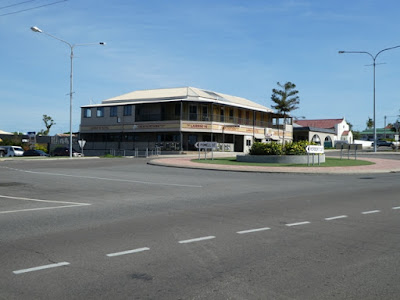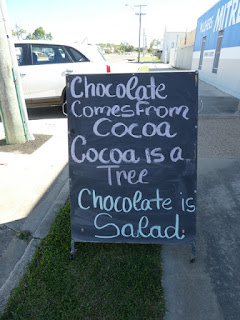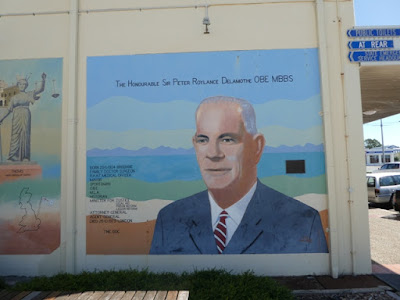Bowen is an interesting place for a number of reasons. One little known and somewhat obscure claim to fame is that it sits exactly twenty degrees south of the equator, but its location on the Queensland Coast is probably more usefully described as being 1,130 kms from Brisbane, or halfway between Mackay and Townsville.
The town lies on a square peninsula, surrounded on all sides but the west by the Coral Sea. This feature of the local topography can create some difficulties in trying to present a pictorial overview of the town, so, true to form, let me set the scene with good old Google Earth in the hope that this will be useful as we explore the town and its surrounds.
The main CBD, which is the subject of today's offering, can be seen in the bottom section of this shot. The red dot more or less in the centre of this area represents the Bowen Post Office in Herbert Street, essentially the town's main street, a street we shall visit in some detail. In the right bottom corner of main built up area are the protective walls of the town marina and small boat harbour, whilst the main town wharf extends south-east from the Esplanade.
The sandy bed of the Don River can been seen winding through the photo to its mouth at the very top of the photo where it estuary lies at the northern end of Queens Beach (not too far from our caravan park).
Bowen has a population of just under 10,000 souls and the combination of its unusually (for the tropics) dry climate and the fertile soils of the alluvial plains to the west of the town along and beyond the Don River present ideal growing conditions for crops such as tomatoes, melons and capsicum.
Tomatoes, tomatoes, tomatoes. The crop grown in this district during the middle of the year is the largest in the country.....$160 million worth. Together with those from the Gascoyne region of WA, these tomatoes ensure a constant supply for the populations of the southern states during the harsher months of winter. And this production accounts for an enormous influx of seasonal workers who descend on Bowen in their masses for three months or so. It is estimated that over 3,000 of them swarm like locusts along the rows of trellises during the picking season.
Tomatoes, tomatoes, tomatoes. The crop grown in this district during the middle of the year is the largest in the country.....$160 million worth. Together with those from the Gascoyne region of WA, these tomatoes ensure a constant supply for the populations of the southern states during the harsher months of winter. And this production accounts for an enormous influx of seasonal workers who descend on Bowen in their masses for three months or so. It is estimated that over 3,000 of them swarm like locusts along the rows of trellises during the picking season.
Having said that, however, this year promises to be quite different. Cyclone Debbie, or more to the point, the massive downpours of rain which accompanied her progress over Bowen, resulted in almost total crop destruction throughout the region. Whilst the area has now dried out and re-planting is being undertaken at a frantic pace, tomatoes are likely to be in short supply throughout the remainder of 2017.
Apart from the horticulture, the Bowen district sustains a significant commercial fishery, beef cattle graze in abundance on the grassy plains beyond the market gardens, and, by way of complete contrast, the town is 'home' to the nearby massive Abbot Point coal loading facility (I'll have more to say about this later).

looks south-east down the slope along Herbert Street to the waters of Port Denison. Despite the fact that the two towns are really quite different in their history and 'feel', we did note some real similarities between Bowen and Gladstone, one of which is that they are both located on quite hilly sites as the drop along Herbert Street demonstrates.
From this same point, looking back in the opposite direction, we can see the divided carriageway of this main street where it had brought us into the CBD from the northern suburbs of the town.
Opposite the War Memorial the whitewashed walls of the local Anglican Church building gleam in the sunlight. This was our first taste of what can be quite 'different' local architecture.
I read somewhere that despite the fact that Bowen lies within the Whitsunday region, where tourism is such a drawcard industry, it could be described as a town which has turned its back on the trappings and colour of the high end tourism and is comfortable in its own skin, old and somewhat shabby that this may be in places. After traipsing about the town extensively, I would happily endorse these observations, as I hope some of the photos will show.
We set off down Herbert Street to see what we could find.


The south-eastern corner of the intersection is occupied by the large stone building which is home to the Whitsunday Regional Council.
On the approach to the next intersection, the rear of this, Bowen's mostimpressive building (author's comment) stands out.
Its sheer size and the style of architecture do really set it apart from the other major buildings in the CBD. After all, we cannot have a town Court House which is anything but imposing can we?
Almost opposite Bowen's 'house of justice' is its 'house of learning', the local library,
not far beyond which we arrived at the Williams Street intersection.
Here, from the raised street crossing walkway, we could see down to the waters of Port Denison past what now became a real cluster of commercial enterprises.
And it was in this section of the street that we came across something we've never seen before, even in towns with much more tropical humidity. Nothing odd about this, I hear you sniff. What's the big deal about a street based ATM?
Well not a lot I guess at the front that is. But the rear told a very different story. I mean to say, I always expect my cash to be secured in air conditioned comfort! And this is known as the dry tropics.
Moving right along, our jaunt down Herbert Street had by now taken us almost to its far end.
As we passed under the footpath shelter provided by the sturdy balcony of the Grand View Hotel
we arrived at the corner of Dalrymple Street, where glimpses of the town wharf and the
brightly coloured advertising flags of the Bowen Tourist Information Centre came into view across the open ground which, some years ago, had a very special role. This was the site at which much of that blockbuster film 'Australia' was made, but more of that later.
The Grand View Hotel is well named. It certainly does provided a view to the port and is grand indeed.
On the opposite side of Herbert Street is another of Bowen's highly recognisable old buildings.
Now occupied by a Government Department, this impressive structure, with its distinctive front tower, was used in 'Australia' as the headquarters of a cattle baron, one of the leading figures in the film.
On the seaward side of this intersection we had a reminder of the significance of backpackers in the Bowen's industrial scene. Almost hidden by surrounding trees, this is one of the town's large backpacker hostels
The sign at the front of the complex advertises a service which is attracting significantly increased attention by both the authorities and the media. The horrific murder of the British lass at the Home Hill backpacker hostel last year has brought this industry into sharp focus.
Many are now arguing that those who provide accommodation should not be involved in arranging work placements, and, in my view, with good reason. Unscrupulous hostel owners are well known for promising work to their temporary tenants, demanding up-front accommodation fees and then failing to make good on their promises of employment. The upshot, of course, sees many foreign workers (and no matter what we may think about this, the country cannot do without them.....until a few more Australians are prepared to get off their collective unemployed butts and pick fruit and vegetables, that is) incurring an on-going rent debt with no means by which to repay it.
This, and sexual and other forms of exploitation, is a vexed and no-going issue throughout all areas of the country in which these workers assemble to harvest produce, much of which is unavoidably highly labour intensive and for which the level of payment is unattractive to the locals.
Many of the producers are opposed to any form of government intervention or regulation, mainly because they are afraid that the imposition of more equitable working conditions and payments will adversely affect their bottom line. They remain content to take a 'hands off' approach to the provision of their labour, a situation which plays right into the hands of unscrupulous labour hire organisations. I think this entire issue is very much a case of 'watch this space'.
But enough of social commentary.....let's get back to the streets of Bowen.
One aspect of the CBD which struck us as we wandered about was the width of the streets which run off at right angles to Herbert Street. This is a classic example.
Gregory Street, which parallels Herbert, is also home to many commercial enterprises, where clusters of businesses seem to have sprung up in quite disparate areas of the CBD.
At this point we found the Bowen Hotel, a far less imposing building than a few of its competing hostelries, but one we were reliably and quite forcefully informed by a group of locals, 'is the best pub in town for a feed.' Our social calender did not allow us the time to check!
The side streets also threw up some quaint little buildings, typical of old Bowen, such as this which houses the Bowen Medical Centre,
this, the epitome of a good old fashioned barber's shop
and the town RSL building, all of which demonstrate a certain style which we found not only typical of Bowen but supportive of the comment that those who live and work here are unfazed by any push to 'go up-market'.
This does bring personal preference into some focus. I was very much at home in this environment of unpretentious sprawl, but Liz found the town a tad scruffy looking and not entirely to her taste. Each to his or her own.
Throughout our ramble we were on the lookout for cyclone damage, of which we saw surprisingly little. We understand that the town clean up effort immediately after Debbie's passage was massive, and that was clear, although there was still the odd reminder or two to be seen.
And what's a good gallop around a town without a snappy sign or two? One of the side streets of Bowen obliged with this gem of rationalisation, an interesting example of syllogistic reasoning if ever one existed!
Irrespective of any personal opinion about the town's buildings, there is one aspect of the town centre about which Bowen can boast a serious claim to fame......murals, all twenty-eight of them!
These depict a wide range of Bowen life, both historical and current, and can be discovered throughout the CBD and beyond. Very good local guides can be found in all the relevant tourist blurb, and although we did not embark on a specific campaign of discovery, we could not help but run across many as we roamed the streets.
And no, dear reader, you'll not have to fast forward past all twenty-eight, but I must share a few.
Explanatory notes accompany the guides, but we found that in most instances each offering was more or less self explanatory.
They varied enormously in style, subject and situation. There are some which one could not help but trip over,
whilst others are tucked away in the most odd spots
on the sides of various (usually) relevant, buildings.
And, as I mentioned before, the subject matter is wide ranging, from scenes of the town's pioneering past,
through to recognition of modern day services,
the efforts of civic groups,
and acknowledgement of a local luminary of serious significance to the town, the State and indeed the country.
In all they do present a wonderful pictorial presentation of much of Bowen life and certainly boost the town's tourist potential,even if we did come across them more or less by accident after we had arrived!





































No comments:
Post a Comment